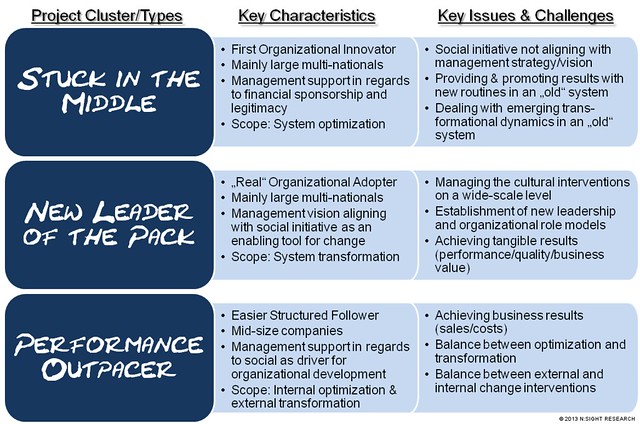Every year in autumn I have to get my mind clear on what key questions we want to address with the next Enterprise 2.0 SUMMIT and – I can tell you – every year it becomes more difficult – especially as the evolution path towards the somewhat “social and collaborative organization” is not as easy as it was thought to be. But as the vision of the conference is to provide assistance for corporate project leads to advance their projects our task for the conference is still to provide answers.
If we take a look at the actual state of the project evolution – esprecially in Europe-, we have to state that is far from “good looking”. While various research results have shown that the use of collaborative technologies within the enterprises has taken up speed, the transformative outcome from these projects is more than poor.
Though corporate management is largely ackknowledging the ideas of social networking behind the firewall and supporting initiatives with money and legitimation, many projects are also struggling – on different levels. From my humble observation I am categorizing the project landscape in 2013 in three different clusters that I like to discribe in the following:
Stuck in the middle of the trough of disillusionment
The first cluster of projects consists of those early adopters in the Enterprise 2.0 field. They are somehow the first generation of projects that introduced “social initiatives” on a enterprise-wide scale to establish new forms of collaboration and working within their organizations.
These projects have been taking large efforts to get co-workers connected and on-board for the new way of working. The projects can be characterized by a already large “operational movement” on a social environment and quite a number of important business collaboration running on these provided platforms. Change can be seen on the level of the individual adoption not only for using the tools but also for the new mindset.
But while these projects provide good returns on the individual and team level, the change on a group or even organizational level is poor. And this fact often leads to problems of mis-interpretation of the collaborative value by corporate leaders because they do not understand or cannot accept the value out of it – as the collaborative value creation process (of people interacting interdisciplinary) is opposing the accepted system of leadership and organization.
Many consultants and analysts therefore already position these projects as failure because they are not achieving the “real” change of working in the company – and each of these critics have another good advice on how to do it better!
But IMHO – we have to say “Chapeau!” to the project leads behind these first generation projects and state that their projects are not a failure but in a difficult situation! The only way to success is for them to act as the “fearless change agents” to help advancing these projects on many levels.
Because the problem is that they are “running against the machine”. Though the top management might support these projects financially, it is mostly not part of the key strategic actions. And very few project leads have the chance to question this. The key problem is that transformative nature of these new ways of collaboration do not fit with the existing organizational model. And as long as the top management is not perceiving the need to change the business model and the organization they will certainly “not change the running system”!
Therefore these project leads are limited to their adoption efforts and small interventional actions on team and group level. It is very much important for them to get the recognition of the work internally and externally to support the steady path of change and to let the transformative nature of social platforms and routines work for them in the long run!
Thus the big issues in these projects are to better do the adoption, engagement and community management, to change the individual and group way of working more effectively and also to have a better sense on how to align “social” with business objectives on the team and group level and therefore indirectly also on an organizational level.
Watching the new leaders of the pack taking off to new heights!
While many first generation projects are in the above described situation, there are also some new lighthouse projects that seem to do it better. One of these second generation projects is Robert Bosch.
As one of the directors of the Bosch initiative Marc Musse stated in our blog:
Also at Bosch there is a project ‘starting off at another level with the social business challenge’, here the focus is on organizational and cultural change.
The motivation behind the project is very much driven by the external and market-driven demand for innovation to be successful in the future and to guarantee further growth and market success for Bosch. The internal project at Bosch is an holistic anwer to the question the Bosch’ CEO Volkmer Denner is somehow “chased” by: “How can we ignite the potential and creativity of more than 300,000 people in this company to a firework of new ideas, improvements and innovations?” The answer is a new way of collaborative working – established in the systems of leadership and cooperation! It’s this externally driven market demand that is imposing a need for change internally and for that “social” is an enabling tool to achieve this objective.
There are more examples for this approach like Continental, Solvay or also Atos (and yes – I know mentioning Atos is controversial as they are also a consulting firm and solution provider in this field!).
In many ways all these projects are driven by a cultural change approach requested by the top management. The corporate behavior change actions are the core activities of these projects established in different approaches to it – like providing a global advocate program for the re-thinking (like at Continental), organising a company-wide convention to find new corporate values (like at Solvay) or defining the avoidance of undesirable corporate behavior as a part of the staff performance evaluation (like at Atos with the Zero Email Program). The “social platform” and the use of it – is a solution and an enabler for realizing the cultural objective.
But also to be honest for the evaluation of these projects – while they are driven by a more holistic and change driven support by the top management they still have to fulfill the expectations on the individual and group level. And therefore they are also facing the ordinary problems on providing the answer for the “What’s-In-It-For-Me” question on the individual level. While the “big vision” may be the “corporate behavior change” and the “re-modeling of the company” the initiated use of the platforms also need to support tangible business objectices – like improving the business performance or improving the process and output quality.
The key issues for these projects are therefore – on the one side finding and defining new models for leadership and the organizational structure and on the other side also sucessfully driving the adoption and engagement management on the individual and group level.
Trying to outpace performance on the late follower side
As a third cluster in this project landscape we are seeing the crowd of late following companies emerging. The companies in this crowd can be characterized to be mainly smaller in size – subsequently the layer of middle management is much thinner and less impedimentar and less problematical. The top management is much more connected with project and involved in the “social initiative”. Furthermore the “social initiative” usually are much more business orientated – as this smaller sized organization do not have any budget to throw away!
Certainly – the late following crowd does not want to make the same mistakes as the forerunners. Therefore they are very keen on the right project approach and steps. The project management needs to provide a clear justification for the investment and cannot “run and test” the “social way”. Most of the projects evolve out of classical “Intranet” projects that have become too complex, too static and too non-conversational in order to support the dynamics of the business. With the introduction of a more “social” and “collaborative” workplace these companies want to enhance the business performance and value creation.
Thus the big challenge in these projects is the “time to market” – respectively the fast realisation of effects and returns. The transformative power of “social” is less important to the deconstruction of beaucratic structures (as mid-size companies have already lesser structures) but for the “leap-frogging” at the market. In this way the social business concepts in this cluster are opening up earlier to the integration of business partners and clients.
Let’s start “Getting Social Enterprise Ready”!
As the discussion of the perceived clusters is making clear – there is still no one way to the success in the “social” world. Furthermore the project approach is very different from where you start! And last but not least – it’s all about the understanding that “social technology” is only the “enabling” tool for a performance or transformative objective. The snag of these technologies is that even if they only should serve business performance objective they introduce the little “trojan mice” with the transformative nature at the end.
Anyhow – in regards to the upcoming Enterprise 2.0 SUMMIT 2014 we decided that projects and project members need to get “Social Enterprise Ready”. With this we want to discuss how to face the challenges on the way to a more business orientated approach and how to solve the project issues on the way to success. This said – this year’s conference program is again keyed around practical insights from case studies and expert discussions on the project management issues. The case studies are structured by how they are enabling different business objectives. The project issues focus on the topics of change management, engagement/adoption/community management, social process alignment and the definition of new leadership and organizational models. Furthermore we again provide lots of interactive sessions for the exchange of experiences and the hands-on application of the gained insights from the conference.
In brief – we are very much excited about the next edition of the conference with already a great line-up (still to be finished with more exciting speakers to be announced shortly!). So while the registration is up and open for your booking, I am also very interested in your feedback of my above unveiled perception of the project landscape in the (at least European) Social Enterprise field!









 Good signs for #e20s 2014 becoming a blast!
Good signs for #e20s 2014 becoming a blast!
 Enterprise 2.0 Summit is a great place for conversations with real users and experts
Enterprise 2.0 Summit is a great place for conversations with real users and experts Social Business - Das Nischendasein muss ein Ende haben!
Social Business - Das Nischendasein muss ein Ende haben! Social Workplace Adoption and how-to succeed with Social!
Social Workplace Adoption and how-to succeed with Social! An energetic adoption lead is the key to success for the social adoption!
An energetic adoption lead is the key to success for the social adoption!
Hi Björn,
thanks so much for not joining the “Social Business/E20 is dead” chorus that has been taking up volume lately, mainly driven by consultancies. I find you analysis very sound.
Since I was part of one “first organizational innovator” projects, I can relate to very much you write on this first cluster. However, I believe there are ways out of the trough of disillusionment for us pioneers. They will be different for each company. Some may succeed in linking their social business subculture to a behavior change initiative, others may focus on achieving tangible business results.
I am very impressed by some examples of the second cluster I see in Europe. They learned from the early movers – and now they give us something back. It will be interesting to follow their journey in the next years. There may still be the odd through of disillusionment waiting for them. Hopefully then they can rely on the innovators for some inspiration how to get out of this dint.
The third cluster sounds fascinating. Here I don’t know many examples. Björn, it would be great if you could share some.
One more question: How much do you plan to use this clustering in the actual E20 Summit next year? A clear distinction by clusters might make it easier for everyone to decide between the sessions running in parallel.
Cordial greetings,
Cordelia
Cordelia – thank you by your kind comments. In my opinion the “first generation” had not had the chance to tackle an organizational vision with social, the second generation is aligned to it – but also damned to it! While the first generation still can evolve and continue with the project, the second can only do it right – or go home! Regarding the third group – look at the list of case studies at IOM SUMMIT 2013.
Regarding #e20s 2014 – we are still working on a clear guidance at the conference. The derived challenges from the above discussion was clearly structuring the way of thinking in regards to the programm – as for the structuring of case studies by their enabling scope of business objectives, for the big topics of the expert discussion (how-to do change management, how-to do engagement/internal community management, how-to align social and processes and how-to define the leadership and org models) as well as for the interactive sessions. Looking very much forward to it.
Regards. Bjoern